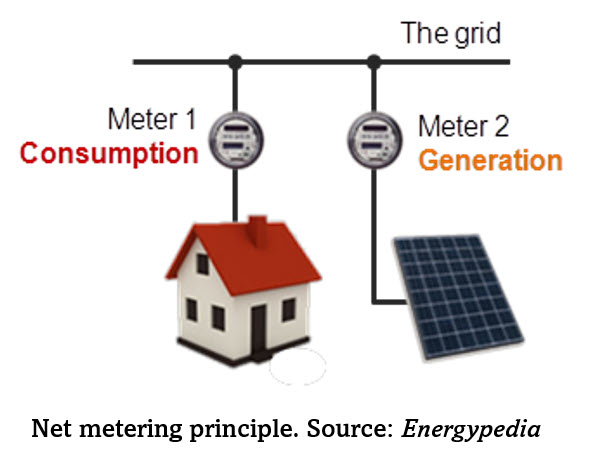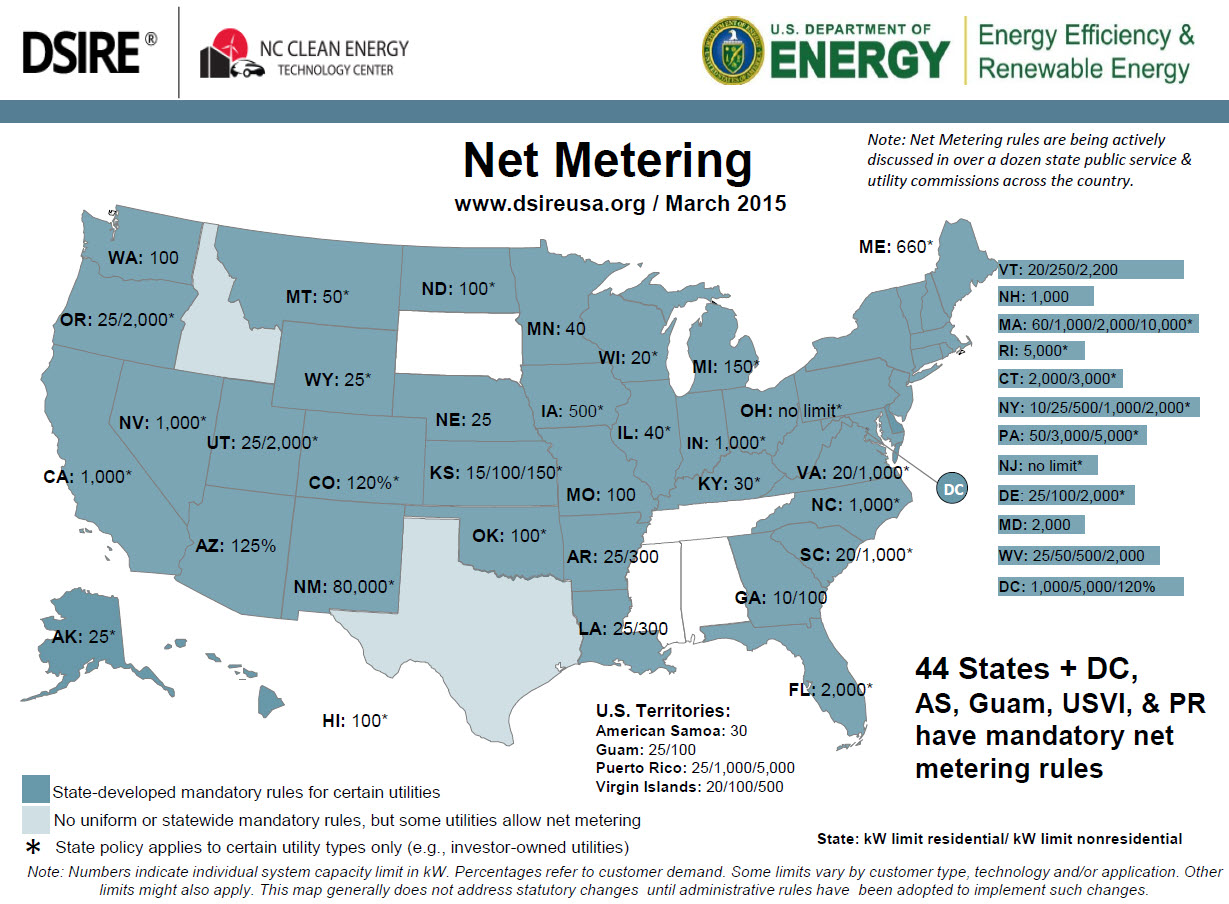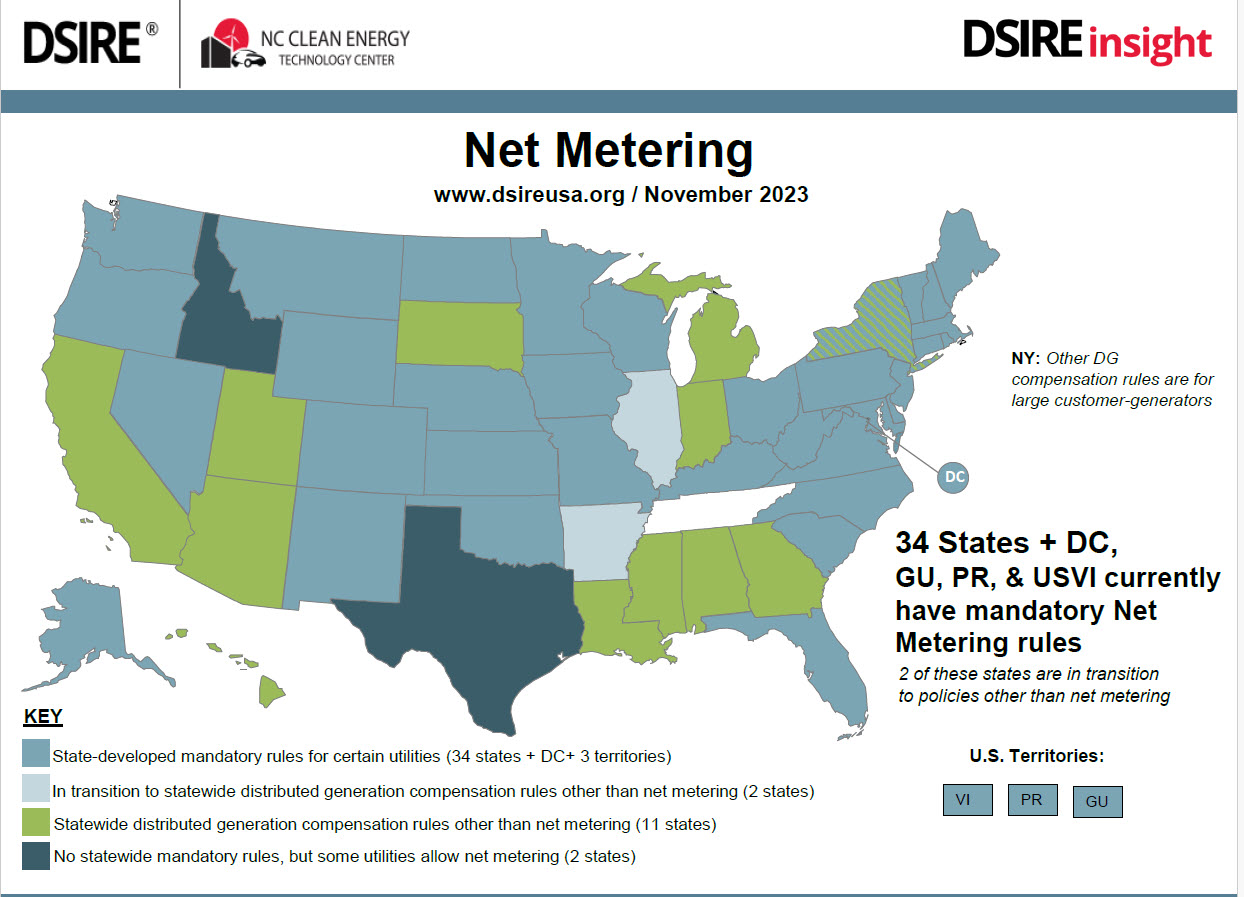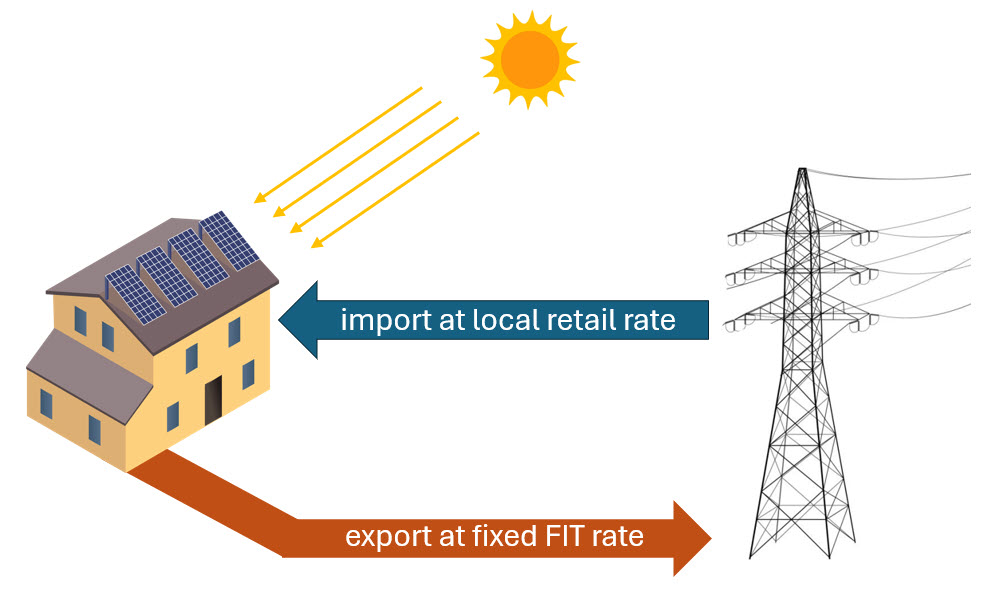9.3 USA: Interstate Renewable Energy Policy and Permitting
Net Metering

One of the adopted trends from the past decade of photovoltaic adoption is the ability to connect your solar system directly into the power grid. Policies have been adopted to allow renewable generators (both commercial and residential) to "bank" excess power into the grid and receive credits for it from the utility. In this case, if you generate as much energy on site as you consume from the grid, your net energy balance is zero, and so is your energy bill! This is of course the case if the utility company reimburses you for each kWh at the same rate as you pay for the kWh drawn from the grid. This is called Net Metering.
But each locale will be subject to different policies enabling or prohibiting such practices. Net metering is expanding in creative ways, including aggregation of multiple distributed energy sources for credit, and distributing joint credit from a centralized solar garden [1] among multiple participants in a community.
Here are some typical Q&A’s:
- What if you produce more energy on site than you consume – will you be compensated for those extra kWh supplied to the grid (and make money)?
Typically, the excess would be rolled over to the next billing cycle (month), but at the end of the year, based on the local policy, you may be compensated for extra power produced.
Example: In Florida, extra power credits roll over to the next month (no monthly cash earned). If not used by the end of the year, they are paid off by the utility, but at the wholesale rate (which is lower than retail).
- How is the power balance technically monitored?
The net metering practice would use a bi-directional meter [2] that tracks the energy flowing from the grid to your house and the energy flowing from your solar system to the grid. The kWh difference over a billing cycle is what you are charged for on your energy bill.
- Is there a cap on how much energy can be fed into the grid?
Some utilities may introduce caps to avoid overcharging the grid and also to discourage intentional oversizing of solar systems. Some utilities also set limits for the system capacity that can participate in net metering (for example, in Pennsylvania it is 50 kW for residential systems and 3 MW for non-residential systems).
- Do customers need insurance for their systems connected to the utility grid?
Policies in some states require larger solar systems to purchase liability insurance, which makes their installation more expensive, but necessarily unprofitable. In some cases, insurance is strongly recommended but not required by policy.
- Do all utilities have to provide net-metering?
State policies would spell that out. In many states, only investor-owned utilities (IOU) are required to provide net-metering. Some rural or municipal energy generating cooperatives may offer their own compensation programs but are not required to net-meter.
From the customer’s perspective, it is quite clear that net-metering provides very sensible incentives to system owners in terms of electricity bill savings. But being on the utility side of the net-metering equation is a bit tricker. There are sensible benefits too, but there are also risks. This topic has been a subject for ongoing debate on whether electric utilities win or lose here, and all kinds of pressures were put on policy makers, and policies do seem to differ quite drastically across the states.
Let’s review some of those cons and pros.
Risks to utility
While net metering offers benefits for renewable energy adoption and customer savings, there are several perceived risks for utilities related to revenue, cost recovery, and grid management.
- Revenue. Imagine that there are customers in the utility network that are at “net zero”, so they consume as much as they produce and hence do not pay anything, but the company still has to manage their accounts, provide technical support, billing, and service them. This is how they may be seen as a ‘burden’.
- Fixed costs. Utilities have significant fixed costs related to maintaining and upgrading the electricity grid, including infrastructure, transmission, and distribution. Net metering can reduce the total amount of revenue utilities receive from customers while these fixed costs remain unchanged.
This may have a few negative impacts:
- Utilities become more hesitant to invest in grid infrastructure and maintenance, which may decrease the grid reliability.
- Utilities may choose to increase electricity prices to recover some of those costs, which will also impact customers without solar systems (“cost shifting”).
- Grid stability. High levels of distributed generation can create technical challenges for managing and stabilizing the grid. Due to intermittency of solar generators, and sheer number of power contributors, grid may experience voltage fluctuations and other sorts of instability.
Despite the perceived risks, many utility companies readily pursue net metering and create programs and options for customers. So, there must be some clear benefits as well..
Utility benefits
- Avoided costs and cost savings. By generating power locally, net metering systems can eliminate the need for new, costly infrastructure investments, such as new power plants (once old ones are decommissioned) or transmission lines. As a result, the overall capital expenditures required to meet electricity demand are reduced.
- Reduced transmission losses. Local solar systems, when strategically placed, may help reduce power transmission and associated energy losses. Residential systems are already on the grid and would not require line construction like bigger solar installations sometimes do.
- Grid Resilience. Distributed energy generation can potentially improve grid resilience by providing local power during outages or emergencies. This may reduce the need for backup power generation or additional emergency infrastructure investments.
Probing Question:
From your perspective, do the benefits of net metering outweigh the risks for the utility?
How the policies developed over the last decade
Net metering policies can evolve and change over time, so once profitable, having a solar system on your roof may become less attractive if the local policy landscape becomes unfavorable, or vice versa. Having full information and unbiased assessment of policy and financial model would certainly provide a good foundation for resolving this question.


What we see from these two maps (published 8 years apart) , the number of states requiring net-metering evidently decreased by ten, while several states devised different compensation mechanisms for solar owners. What are they switching to?
Net billing
Net billing is the solar generation compensation policy some of the states are transitioning to from net metering. This shift is presumably caused by some of those utility’s concerns mentioned above.
So how’s net billing different from net metering? Primarily it is the rate you are compensated at for your solar generation.
With conventional net metering, you get the same rate for importing or exporting electricity (retail). With net billing, you import at the retail rate, but you export at the wholesale rate. So, in this case the utility values the power from the rooftop owners the same as the power from the large-scale power plants.
Net billing is a monetary exchange, and SECS owners would receive two billing statements – one for the power they ‘buy’ from the grid, and the other – for the power they ‘sell’ to the grid. Ideally, if you produce a lot more than you consume, chances are that you make some cash on the monthly basis, although for that you would probably have to oversize your solar system to really break even.
In net metering, we count kWh - in net billing, we count $.
What causes the problem is that the kWh produced and kWh consumed are no longer considered the same. Since the solar credits are compensated at a lower rate, net billing makes the solar systems less valuable and increase the payback period. Hence, there is a fear that a shift to net billing may cause significant reduction of rooftop solar business at the local level and statewide.
Examples:
- In Idaho, the net billing set the compensation rate at 5.96 cent per kWh (down from 8.8 cent per kWh when net metering was in effect) (Pickerel [3], 2024)
- In California, NEM 3.0 policy ties the compensation rate to the time of use (hour, day, month), which may lead to up to 75% less compensation for rooftop owners than during net metering (Foushee [4], 2023).
- According to analysts at Wood Mackenzie [5], the financial payback for residential solar systems in California will shift from 5-6 years to 14-15 years as a result of NEM 3.0.
- The sales of residential PV+storage systems in CA spiked from 10% to 60% following reenactment of NET 3.0 in April 2023.
- In Michigan, the net metering and net billing mechanisms are built into the Distributed Generation Program, in which energy used by the residents is rated at retail rate, while any extra kWh produced are rated at a lower credit (Zientara [6], 2024).
- In Indiana, the SA309 net billing policy which ended net metering in 2017, is being appended with “instantaneous netting”, which means that not only the extra kWh produced on site, but all of the kWh produced by the residential solar system are compensated at a lower rate (Lydersen [7], 2022).
- In Utah, Rocky Mountain Power would charge its customers ~10 cents per kWh, but only credits solar owners at ~5 cents per kWh they supply to the grid (and this rate would vary from year to year). The new SB189 policy, attempts to cap the compensation rates at 84% of the retail price to provide more security to residential solar owners (O’Donoghue [8], 2024)
Feed-in Tariffs
A feed-in tariff (FIT) is a policy measure that is somewhat different from net-metering. Here solar energy generators are compensated at a fixed rate different from the retail electricity rates in the area (sometimes at a higher and steadily guaranteed rate) to incentivize and lower the risk of solar installations.
Feed-in-tariff are often linked to long-term contracts (15—25 years).

Any renewable energy producers – business owners, home owners, farmers – are eligible for FIT in the states and countries that have that policy in place. As of 2024, three states – California, Indiana, and New York - have feed-in tariffs (Investopedia [9], 2024), and they are also broadly used in other countries, such as Germany, China, and Japan.
FIT may appear very attractive to small- to medium-scale solar producers since it offers a steady income for a considerable period of time, thus securing payoff of the installed SECS. However, larger commercial producers often choose a more market-driven pathways, such as power purchase agreements (PPA), which offer more space for negotiation and possibly higher revenues under favorable market conditions.
Here are some pros and cons of this policy approach:
|
Pros |
Cons |
|
Guaranteed Payments: Provides a fixed payment for energy produced, offering predictable revenue. |
Fixed Rates: The rates are set and may be lower than market rates, potentially limiting profitability. |
|
Reduced Risk: Mitigates financial risk by ensuring a stable income, regardless of market fluctuations. |
Long-Term Commitment: Requires a commitment to sell energy at fixed rates for a long period, which may not be ideal in rapidly changing markets. |
|
Support for Small Producers: Benefits individuals and small-scale producers who might not otherwise be able to invest in renewable energy. |
Administrative Burden: Involves navigating regulatory requirements, which can be cumbersome for larger entities. |
|
Encourages Investment: Stimulates investment in renewable energy by providing financial certainty. |
Market Disruption: Can potentially disrupt market dynamics by setting prices that may not reflect current supply and demand conditions. |
Time-of-use plans
The idea of “time-of use” generation is that the rates at which you sell electricity back to the grid are not fixed but depend on the time of day. For example, rates are highest from 4 to 9 p.m., when residents come home from work and use electricity. Overnight from 12 a.m. to 6 a.m., energy use is lower because people are sleeping, so rates are also lower. So you would be compelled to sell your electricity during the peak hours since in that case you will get more credits. And that helps the utility address the peak demand more effectively.
Time-of-use energy plans help you save more if you are strategic with electricity use. You can use daytime cheaper electricity (generated by PV) for charging your electric vehicle or a battery. Then during the peak hours, you can use the stored electricity and supply the rest of it to the grid at a higher rate.
Importance of batteries
The time-of-use plans encourage the addition of a solar battery. Stored solar energy can be used during peak hours when the rates are extra high to reduce energy costs by not relying on the grid for electricity. New policies in California (NEM 3.0) especially capitalize on this approach.
Solar Permitting
Permitting is the unseen monster of project development that will slow or stop a project from moving forward. The key rewards of an established permitting process for SECS include reduced costs of installation and faster turnaround from design to deployment. It will be well worth your integrative design team's time to familiarize yourselves with the permitting process for your locale of interest.
Best practices have been itemized by IREC in this material:
Policy and permitting is an evolving pattern in the renewable energy world. As solar energy rolls out to new municipalities, and adoption rates increase, the pressure to establish an efficient permitting process arises. I would like you to review these documents for this part of the lesson:
- IREC/Vote Solar (2013) "Solar Permitting Best Practices [10]." (Accessed from IREC [11])
We can distill those into a few core features that we would hope for in an integrative process that includes permitting:
- speed of processing (expedited processing, online processing);
- transparency of the process (requirements posted online and openly);
- reduced permitting costs (flat fee over value-based fees); and
- supporting permitting staff are knowledgeable of solar installations.